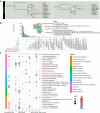Molecular Mechanisms of the Convergent Adaptation of Bathypelagic and Abyssopelagic Fishes
- PMID: 35866587
- PMCID: PMC9348623
- DOI: 10.1093/gbe/evac109
Molecular Mechanisms of the Convergent Adaptation of Bathypelagic and Abyssopelagic Fishes
Abstract
Harsh environments provide opportunities to study how different species adapt, at the molecular level, to similar environmental stressors. High hydrostatic pressure, low temperature, and absence of sunlight in the deep-sea environment are challenging conditions for gene expression, cell morphology and vision. Adaptation of fish to this environment appears independently in at least 22 orders of fish, but it remains uncertain whether these adaptations represent convergent evolution. In this study, we performed comparative genomic analysis of 80 fish species to determine genetic evidences for adaptations to the deep-sea environment. The 80 fishes were divided into six groups according to their order. Positive selection and convergent evolutionary analysis were performed and functional enrichment analysis of candidate genes was performed. Positively selected genes (pik3ca, pik3cg, vcl and sphk2) were identified to be associated with the cytoskeletal response to mechanical forces and gene expression. Consistent signs of molecular convergence genes (grk1, ednrb, and nox1) in dark vision, skin color, and bone rarefaction were revealed. Functional assays of Grk1 showed that the convergent sites improved dark vision in deep-sea fish. By identifying candidate genes and functional profiles potentially involved in cold, dark, and high-pressure responses, the results of this study further enrich the understanding of fish adaptations to deep-sea environments.
Keywords: GRK1; bathypelagic and abyssopelagic fishes; convergent evolution; positive selection.
© The Author(s) 2022. Published by Oxford University Press on behalf of Society for Molecular Biology and Evolution.
Figures






Similar articles
-
Genome sequencing of Coryphaenoides yaquinae reveals convergent and lineage-specific molecular evolution in deep-sea adaptation.Mol Ecol Resour. 2024 Aug;24(6):e13989. doi: 10.1111/1755-0998.13989. Epub 2024 Jun 30. Mol Ecol Resour. 2024. PMID: 38946220
-
Evolution and genetic adaptation of fishes to the deep sea.Cell. 2025 Mar 6;188(5):1393-1408.e13. doi: 10.1016/j.cell.2025.01.002. Cell. 2025. PMID: 40054449
-
De novo transcriptome assembly and positive selection analysis of an individual deep-sea fish.BMC Genomics. 2018 May 24;19(1):394. doi: 10.1186/s12864-018-4720-z. BMC Genomics. 2018. PMID: 29793428 Free PMC article.
-
Vision in the deep sea.Biol Rev Camb Philos Soc. 2004 Aug;79(3):671-712. doi: 10.1017/s1464793103006420. Biol Rev Camb Philos Soc. 2004. PMID: 15366767 Review.
-
The adaptation of biological membranes to temperature and pressure: fish from the deep and cold.J Bioenerg Biomembr. 1989 Feb;21(1):115-35. doi: 10.1007/BF00762215. J Bioenerg Biomembr. 1989. PMID: 2651424 Review.
Cited by
-
The genome of the deep-sea anemone Actinernus sp. contains a mega-array of ANTP-class homeobox genes.Proc Biol Sci. 2023 Oct 25;290(2009):20231563. doi: 10.1098/rspb.2023.1563. Epub 2023 Oct 25. Proc Biol Sci. 2023. PMID: 37876192 Free PMC article.
-
Assembly and annotation of a chromosome-level reference genome for the endangered Colorado pikeminnow (Ptychocheilus lucius).G3 (Bethesda). 2024 Nov 6;14(11):jkae217. doi: 10.1093/g3journal/jkae217. G3 (Bethesda). 2024. PMID: 39268723 Free PMC article.
-
What Does It Mean to Be(Come) Arctic? Functional and Genetic Traits of Arctic- and Temperate-Adapted Diatoms.Glob Chang Biol. 2025 Mar;31(3):e70137. doi: 10.1111/gcb.70137. Glob Chang Biol. 2025. PMID: 40110945 Free PMC article.
References
-
- Altschul SF. 2012. Basic local alignment search tool (BLAST). J Mol Biol. 215:403–410. - PubMed
-
- Andriashev A P. 1953. Ancient deep-water and secondary deep-water fishes and their importance in a zoogeographical analysis. Notes on special problems in ichthyology.
-
- Angel MV. 1997. 1 What is the deep sea? Fish Physiol. 16:1–41.
-
- Bell M, Henderson R, Sargent J. 1986. The role of polyunsaturated fatty acids in fish. Comp Biochem Physiol B 83:711–719. - PubMed
-
- Bennett N, Sitaramayya A. 1988. Inactivation of photoexcited rhodopsin in retinal rods: the roles of rhodopsin kinase and 48-kDa protein (arrestin). Biochemistry 27:1710–1715. - PubMed
Publication types
MeSH terms
LinkOut - more resources
Full Text Sources
Miscellaneous

